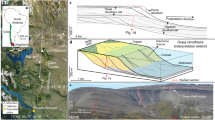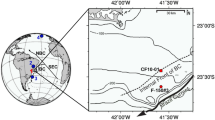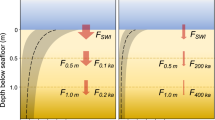Abstract
Continental erosion controls atmospheric carbon dioxide levels on geological timescales through silicate weathering, riverine transport and subsequent burial of organic carbon in oceanic sediments1. The efficiency of organic carbon deposition in sedimentary basins is however limited by the organic carbon load capacity of the sediments and organic carbon oxidation in continental margins. At the global scale, previous studies have suggested that about 70 per cent of riverine organic carbon is returned to the atmosphere, such as in the Amazon basin2,3,4. Here we present a comprehensive organic carbon budget for the Himalayan erosional system, including source rocks, river sediments and marine sediments buried in the Bengal fan. We show that organic carbon export is controlled by sediment properties, and that oxidative loss is negligible during transport and deposition to the ocean. Our results indicate that 70 to 85 per cent of the organic carbon is recent organic matter captured during transport, which serves as a net sink for atmospheric carbon dioxide. The amount of organic carbon deposited in the Bengal basin represents about 10 to 20 per cent of the total terrestrial organic carbon buried in oceanic sediments. High erosion rates in the Himalayas generate high sedimentation rates and low oxygen availability in the Bay of Bengal that sustain the observed extreme organic carbon burial efficiency. Active orogenic systems generate enhanced physical erosion and the resulting organic carbon burial buffers atmospheric carbon dioxide levels, thereby exerting a negative feedback on climate over geological timescales.
This is a preview of subscription content, access via your institution
Access options
Subscribe to this journal
Receive 51 print issues and online access
$199.00 per year
only $3.90 per issue
Buy this article
- Purchase on Springer Link
- Instant access to full article PDF
Prices may be subject to local taxes which are calculated during checkout




Similar content being viewed by others
References
Hayes, J. M., Strauss, H. & Kaufman, A. J. The abundance of 13C in marine organic matter and isotopic fractionation in the global biogeochemical cycle of carbon during the past 800 Ma. Chem. Geol. 161, 103–125 (1999)
Burdige, D. J. Burial of terrestrial organic matter in marine sediments: A re-assessment. Glob. Biogeochem. Cycles 19, GB4011. 1–7 (2005)
Hedges, J. I., Keil, R. G. & Benner, R. What happens to terrestrial organic matter in the ocean? Org. Geochem. 27, 195–212 (1997)
Schlünz, B. & Schneider, R. R. Transport of terrestrial organic carbon to the oceans by rivers: Re-estimating flux and burial rates. Int. J. Earth Sci. 88, 599–606 (2000)
Mackenzie, F. T. in Flux of Organic Carbon by Rivers to the Ocean (eds Likens, G. E. et al.) 360–384 (US Department of Energy, Washington DC, 1981)
Berner, R. A. Atmospheric CO2 levels over Phanerozoic time. Science 249, 1382–1386 (1990)
Curray, J. R., Emmel, F. J. & Moore, D. G. The Bengal Fan: morphology, geometry, stratigraphy, history and processes. Mar. Petrol. Geol. 19, 1191–1223 (2003)
Galy, A. & France-Lanord, C. Higher erosion rates in the Himalaya: Geochemical constraints on riverine fluxes. Geology 29, 23–26 (2001)
Milliman, J. D. & Syvitski, P. M. Geomorphic/tectonic control of sediment discharge to the ocean: The importance of small mountainous rivers. J. Geol. 100, 525–544 (1992)
Aucour, A.-M., France-Lanord, C., Pedoja, K., Pierson-Wickmann, A.-C. & Sheppard, S. M. F. Fluxes and sources of particulate organic carbon in the Ganga-Brahmaputra river system. Glob. Biogeochem. Cycles 20, GB2006. 1–12 (2006)
Subramanian, V. & Ittekkot, V. in Biogeochemistry of Major World Rivers (eds Degens, E. T., Kempe, S. & Richey, J. E.) 157–168 (SCOPE, Paris, 1991)
France-Lanord, C. & Derry, L. A. Organic carbon burial forcing of the carbon cycle from Himalayan erosion. Nature 390, 65–67 (1997)
RSP. Spatial Representation and Analysis of Hydraulic and Morphological Data (Report No. FAP 24, WARPO, Dhaka, Bangladesh, 1996)
Ittekkot, V., Kudrass, H. R., Quadfasel, D. & Unger, D. Bay of Bengal. Deep-sea Res. II 50, 853–1053 (2003)
Hedges, J. I. & Keil, R. G. Sedimentary organic matter preservation: An assessment and speculative synthesis. Mar. Chem. 49, 81–115 (1995)
Wagai, R. & Mayer, L. M. Sorptive stabilization of organic matter in soils by hydrous iron oxides. Geochim. Cosmochim. Acta 71, 25–35 (2007)
Drenzek, N. J., Montlucon, D. B., Yunker, M. B., Macdonald, R. W. & Eglinton, T. I. Constraints on the origin of sedimentary organic carbon in the Beaufort Sea from coupled molecular 13C and 14C measurements. Mar. Chem. 103, 146–162 (2007)
Beck, R. A., Burbank, D. W., Sercombe, W. J., Olson, T. L. & Khan, A. M. Organic carbon exhumation and global warming during the early Himalayan collision. Geology 23, 387–390 (1995)
Pierson-Wickmann, A.-C., Reisberg, L., France-Lanord, C. & Kudrass, H. Os-Sr-Nd results from sediments in the Bay of Bengal: Implications for sediment transport and the marine Os record. Paleoceanography 16, 435–444 (2001)
France-Lanord, C. & Derry, L. A. δ13C of organic carbon in the Bengal Fan: Source evolution and transport of C3 and C4 plant carbon to marine sediments. Geochim. Cosmochim. Acta 58, 4809–4814 (1994)
Freeman, K. H. & Colarusso, L. A. Molecular and isotopic records of C4 grassland expansion in the late Miocene. Geochim. Cosmochim. Acta 65, 1439–1454 (2001)
Meyers, P. A. & Dickens, G. R. in Synthesis of Results from Scientific Drilling in the Indian Ocean (eds Duncan, R. A. et al.) 295–309 (Vol. 70, Geophysical Monograph Series, American Geophysical Union, Washington, 1992)
Suckow, A., Morgenstern, U. & Kudrass, H.-R. Absolute dating of recent sediments in the cyclone-influenced shelf area off Bangladesh: Comparison of gamma spectrometric (137Cs, 210Pb, 228Ra), radiocarbon, and 32Si ages. Radiocarbon 43, 917–927 (2001)
Cai, W.-J. & Sayles, F. L. Oxygen penetration depths and fluxes in marine sediments. Mar. Chem. 52, 123–131 (1996)
Schwenk, T., Spiess, V., Breitzke, M. & Hubscher, C. The architecture and evolution of the Middle Bengal Fan in vicinity of the active channel-levee system imaged by high-resolution seismic data. Mar. Petrol. Geol. 22, 637–656 (2005)
Weber, M. E., Wiedicke, M. H., Kudrass, H. R., Hübscher, C. & Erlenkeuser, H. Active growth of the Bengal Fan during sea-level rise and highstand. Geology 25, 315–318 (1997)
Berner, U., Poggenburg, J., Faber, E., Quadfasel, D. & Frische, A. Methane in ocean waters of the Bay of Bengal: Its sources and exchange with the atmosphere. Deep-sea Res. II 50, 925–950 (2003)
Broecker, W. S., Toggweiler, J. R. & Takahashi, T. The Bay of Bengal — A major nutrient source for the deep Indian Ocean. Earth Planet. Sci. Lett. 49, 506–512 (1980)
Goni, M. A. et al. Distribution and sources of particulate organic matter in the water column and sediments of the Fly River Delta, Gulf of Papua (Papua New Guinea). Estuar. Coast. Shelf Sci. 69, 225–245 (2006)
Kudrass, H. Bengal Fan 45–89 (Sonne cruise 93 final report, BGR, Hannover, Germany, 1996)
Cochran, J. R. et al. Proc. ODP Init. Rep. 116, 388 (1989)
Galy, A., France-Lanord, C. & Derry, L. A. The strontium isotopic budget of Himalayan rivers in Nepal and Bangladesh. Geochim. Cosmochim. Acta 63, 1905–1925 (1999)
von der Borch, C. C. et al. Initial Report of the Deep Sea Drilling Project Vol. 22 (US Government Printing Office, Washington, 1974)
Beyssac, O. et al. On the characterisation of disordered and heterogenous carbonaceous materials by Raman spectroscopy. Spectrochim. Acta A 59, 2267–2276 (2003)
Beyssac, O., Rouzaud, J.-N., Goffé, B., Brunet, F. & Chopin, C. Graphitization in a high-pressure, low temperature gradient: A Raman microspectroscopy and HRTEM study. Contrib. Mineral. Petrol. 143, 19–31 (2002)
Acknowledgements
This study was funded by CNRS-INSU programmes Eclipse and Relief de la Terre. We thank A. Gajurel and M. Rahman for help during the sampling of river sediments; C. Guilmette for technical assistance in the stable isotopes laboratory; and P. Burnard and L. Reisberg for improving the quality of the text.
Author Contributions V.G. and C.F.L. are the main authors. O.B. conducted the fossil Corg characterization. P.F. and F.P. were involved in the organic geochemistry part of the study. H.K. provided the Bengal fan sediments and the framework of sedimentological interpretation.
Author information
Authors and Affiliations
Corresponding author
Ethics declarations
Competing interests
The authors declare no competing financial interests.
Supplementary information
Supplementary Information
The file contains Supplementary Discussion with additional references, Supplementary Figures 1-7 with Legends and Supplementary Tables 1-3. This section comprises a supplementary discussion on: (1) fossil Corg detection and, (2) sources of Corg in Bengal Fan sediments. The Supplementary Figures and Supplementary Tables support both the main text and the supplementary discussion. (PDF 2875 kb)
Rights and permissions
About this article
Cite this article
Galy, V., France-Lanord, C., Beyssac, O. et al. Efficient organic carbon burial in the Bengal fan sustained by the Himalayan erosional system. Nature 450, 407–410 (2007). https://doi.org/10.1038/nature06273
Received:
Accepted:
Published:
Issue Date:
DOI: https://doi.org/10.1038/nature06273
This article is cited by
-
Palaeozoic cooling modulated by ophiolite weathering through organic carbon preservation
Nature Geoscience (2024)
-
Anthropogenic impacts on mud and organic carbon cycling
Nature Geoscience (2024)
-
Circulation of hydraulically ponded turbidity currents and the filling of continental slope minibasins
Nature Communications (2024)
-
Isotopic Composition of Carbon and Nitrogen of Particulate Organic Matter in the Godavari Estuary: Seasonality in Sources and Processes
Estuaries and Coasts (2024)
-
Detailed monitoring reveals the nature of submarine turbidity currents
Nature Reviews Earth & Environment (2023)
Comments
By submitting a comment you agree to abide by our Terms and Community Guidelines. If you find something abusive or that does not comply with our terms or guidelines please flag it as inappropriate.



